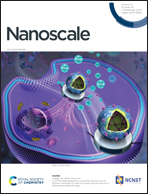Building in biologically appropriate multifunctionality in aqueous copper indium selenide-based quantum dots†
Abstract
Advanced nanoplatforms equipped with different functional moieties for theranostics hold appealing promise for reshaping precision medicine. The reliable construction of an individual nanomaterial with intrinsic near-infrared (NIR) photofunction and magnetic domains is much desired but largely unexplored in a direct aqueous synthesis system. Herein, we develop an aqueous phase synthetic strategy for Mn2+ doping of ZnS shell grown on Zn–Cu–In–Se core quantum dots (ZCISe@ZnS:Mn QDs), providing the optimal NIR fluorescence quantum efficiency of up to 18.9% and meanwhile efficiently introducing paramagnetic domains. The relaxometric properties of the water-soluble Mn-doped QDs make them desirable for both the longitudinal and transverse (T1 and T2) magnetic resonance (MR) contrast enhancement due to the shell lattice-doped Mn2+ ions with slow tumbling rates and favoured spin-proton dipolar interactions with surrounding water molecules. Surprisingly, the incorporation of Mn2+ ions into the shell is found to significantly enhance the production of reactive oxygen species (ROS) by combining both the chemodynamic and photodynamic processes upon NIR light irradiation, showing great potential for efficient photo-assisted ablation of cancer cells. Furthermore, a broad-spectrum excitation range beneficial for bright NIR fluorescence imaging of breast cancer has been proven and offers high flexibility in the choice of incident light sources. Multiparametric MR imaging of the brain has also been successfully demonstrated in vivo.

- This article is part of the themed collection: Celebrating 25 years of the Key Laboratory for Special Functional Materials at Henan University


 Please wait while we load your content...
Please wait while we load your content...